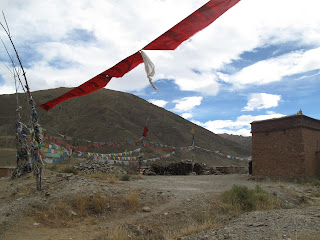After our first night in Tsedang, capital of the Yarlung valley, and ghost town of the Chinese tiles we set off for the fortress/chapel of Yumbulakhang. I had seen photos of this building high on the hill, and i was excited to see it. Its been rebuilt of course, so it's not the original anymore, and to be honest although i was worrying about all the things i've spoken about in my previous blogs and didn't know what to think. This is the chapel with the vacant seat of the Panchen lama and where i was first struck by the Mao money everywhere. But it also has the most magnificent vista, and infront of the temple in a field to the left is where the first cultivated field in Tibet was supposed to be sewn from the first Tibetans who in their beliefs descended from monkeys.
I climbed up to the top of the mountain behind the temple and watched the few pilgrims go up the path. Its really quite incredible, and now i'm home i can't believe that last week i was standing there with the wind in my hair looking out over the Tibetan fields below.
Here's a picture of some of the money collected in the temple
 Monk population in this little temple = 3 i think. Monk populations all over Tibet are dwindling. Temples without monks are a very sad affair.
Monk population in this little temple = 3 i think. Monk populations all over Tibet are dwindling. Temples without monks are a very sad affair. Next stop was the Traduk monastery which is being rebuilt after being mostly destroyed during the 'Cultural revolution' (occupation)
Next stop was the Traduk monastery which is being rebuilt after being mostly destroyed during the 'Cultural revolution' (occupation)On the back of my ticket into the temple it says "Traduk Lamasery is one of the twelve Tibetan Buddhist lama temples buillt by the Tibetan king Songtsen Gampo in the 7th century as well as one of the important sacred places among the three sacred pagodas, three sacred caves and three sacred places Yarlung Valley. The temple was constantly maintained in the different stages of history. It remains what it is after is was renovated and added to on a large scale during the time of Tahle Lama X. It is a major national culture relic worthy of preservation."
* Postage stamp on the back of the card from The People's Republic of China
Translation by cynical Londoner: tourists will like this place, so we are rebuilding it after having destroyed it
It was however in this temple under what was a very grey sky i began to get a feel for the fact that Tibetan culture still lives. As although the vistas and views are spectacular it was the people and warmth and smiles i wanted to see. Then we were lucky enough to witness some ladies laying the new floor on the upstairs of the temple. This wasn't something organised by the Chinese for tourists, this was just something we walked in on.
And from that point on my time in Tibet got a lot brighter.

We went to the Tomb of the Tibetan Kings where there was a new old monastery (circa 1982) and i made friends with a Tibetan lady who'd gone a bit mad and she gave me a crystal. Then we made friends with some people in the fields and i tried to make friends with some Yak.
I began to get a feel for the Tibetan people and started trying to understand who was who and what their intentions were. From being utterly shocked when we first got to Tibet, i started being incredibly happy and grateful to be here, witnessing the real geniune smiles of the Tibetans in their own land.








No comments:
Post a Comment